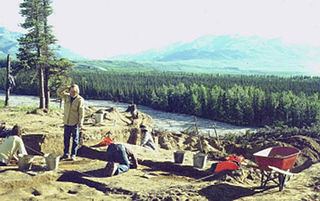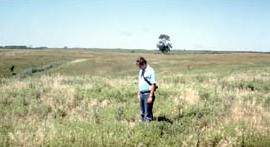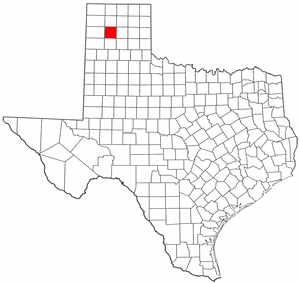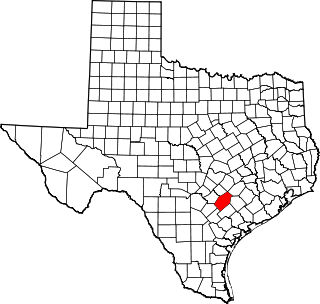Landergin Mesa | |
| Location | Address restricted [1] |
|---|---|
| Nearest city | Vega, Texas |
| Built | 1300 |
| NRHP reference No. | 66000821 [2] |
| Significant dates | |
| Added to NRHP | October 15, 1966 |
| Designated NHL | July 19, 1964 [3] |
Landergin Mesa, near Vega, Texas, is an archeological site, preserving some of the most significant Texas Panhandle culture ruins. Landergin Mesa is a large site with many isolated structures, it is important because of the unique artifacts dating to the Antelope Creek Phase. There are well preserved examples of Borger Cordmarked ceramic vessels from the period. The site also exhibits unique architecture indicative of the Antelope Creek Phase.
Landergin Mesa is a mesa in Oldham County, Texas, in the watershed of the Canadian River. The mesa, relatively modest in scale, rising about 180 feet (55 m) above the valley floor, and has relatively steep sides, features which would have provided a highly defensible position with views across the surrounding countryside. [4] The top layer of the mesa is a thick sandstone, with a sheer drop around much of the mesa's circumference. The mesa's usable surface is covered by a large building remnant with many chambers. An area outside the structure is littered with evidence of domestic occupation, including manos and pottery remains. The site has regularly been subjected to archaeological vandalism by pothunters. The areas in the valley below the mesa, and other nearby landforms, also exhibit evidence of prehistoric human habitation. Radiocarbon dating places the period of occupation around 1300 CE. [5]

The Amalik Bay Archeological District is a geographic area with a significant number of archaeological sites in Alaska. It is located on the Pacific coast of Katmai National Park and Preserve, in the mainland portion of Kodiak Island Borough, Alaska.

The Dry Creek Archeological Site is an archaeological site not far outside Denali National Park and Preserve. It is a multi-component site, whose stratified remains have yielded evidence of human occupation as far back as 11,000 years ago. The site is located on the northern flanks of the Alaska Range, near Healy, Alaska, in the Nenana River watershed. There are four major components to the site, layered in an outwash terrace overlooking Dry Creek, with layers of loess separating them.

The Bloom Site, designated by the Smithsonian trinomial 39HS1, is an archaeological site in Hanson County, South Dakota. It was declared a National Historic Landmark in 1964.

This is a list of the National Register of Historic Places listings in Potter County, Texas

This is a list of the National Register of Historic Places listings in Bowie County, Texas.

This is a list of the National Register of Historic Places listings in Austin County, Texas.

List of NRHP-registered historic places in Lubbock County, Texas

This is a list of the National Register of Historic Places listings in Oldham County, Texas

This is a list of the National Register of Historic Places in Presidio County, Texas
The Burro Mesa Archeological District encompasses a quarry in Big Bend National Park used by Native Americans as a source of chert for chipped-stone tools. The quarry was used intermittently beginning in the paleoindian period starting about 12,000 to 13,000 years ago. The chert is found in a variety of colors and rests on top of tuff beds which themselves contain veins of kaolinite that was suitable for making claystone ornaments and beads. The quarry area is carpeted with lithic debris from the initial knapping process by which chert was rough-shaped into material of suitable size and shape for later refinement at more convenient locations.

This is a list of the National Register of Historic Places listings in Chambers County, Texas.

This is a list of the National Register of Historic Places listings in Gonzales County, Texas.

This is a list of the National Register of Historic Places listings in Garza County, Texas.

This is a list of the National Register of Historic Places listings in Aransas County, Texas.

This is a list of the National Register of Historic Places listings in Rains County, Texas.

This is a list of the National Register of Historic Places listings in Terrell County, Texas.

This is a list of the National Register of Historic Places listings in Andrews County, Texas.

This is a list of the National Register of Historic Places listings in Hale County, Texas.

This is a list of the National Register of Historic Places listings in McMullen County, Texas.

This is a list of the National Register of Historic Places listings in Schleicher County, Texas.
{{cite journal}}: Cite journal requires |journal= (help)Meier, Holly A. (Fall 2007). "TAS Donors Fund Research—Antelope Creek Phase Ceramics" (PDF). Texas Archeology. Texas Archeological Society. 51 (4): 17–18. Retrieved September 22, 2017.